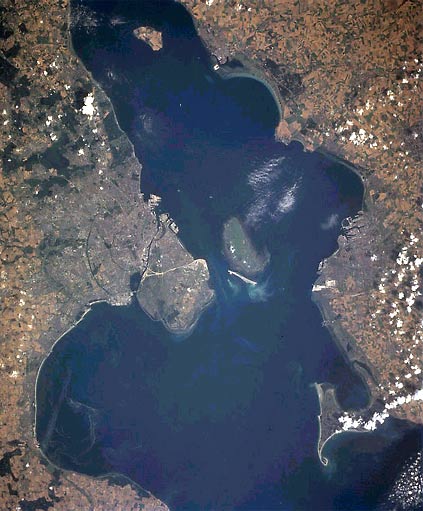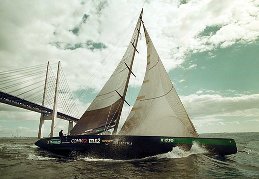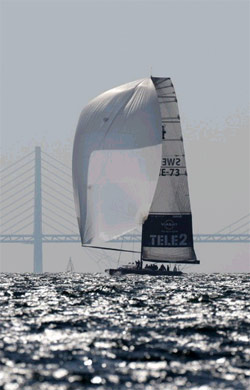|
|
 |
 |
|
 |
|
For the first time ever America's Cup racing comes to Northern Europe in the Malmö-Skåne region of Sweden. We want to express appreciation to Mats, our man in Stockholm, for researching and writing the profile below for the benefit of CupInfo readers.
Let's Regatta! |
|
Malmö, Sweden
Sailing in Sweden Sailing is not a big sport in Sweden. Recreational sailing however is very popular and beer-can racing is common. The sailing capital of Sweden is Gothenburg, which is an exception to the previous statement that sailing is not big in Sweden. In Gothenburg sailing is big. If you walk up to an average Swede in Stockholm and ask him or her what they think about the America’s Cup, you’ll probably get “America’s what?” as an answer. Few people follow the Cup racing and there is not much media coverage. Sailing is underrepresented in media as a whole. Strangely enough, despite the low popularity of the sport in Sweden, there are many very talented and successful Swedish sailors, and Sweden always seems to have a finger in the game when it comes to big sailing events. Sweden has had one or more entries in every Whitbread/Volvo Ocean Race since 1989 and many Swedish sailors have competed. The Swedish Match tour pretty much speaks for itself, with Magnus Holmberg (currently skipper of Victory Challenge) winning the tour once and being runner-up on two occasions. Freddy Lööf has proven his valor both in the Finn and later the Star, winning the Star worlds twice. Marie Björling is ranked number one on the ISAF match racing rankings for women. Other notable Swedish sailors are (in no particular order, and probably leaving many out):
Another funny thing about the Swedish interest in sailing is that even though most people you talk to don’t care much about sailing, when there is an event like the Volvo Ocean Race stopover in Gothenburg in 2002, people turn up in boats and on the beaches by the hundreds of thousands. Probably we’ll see the same thing during the acts in Malmö. Sweden, Victory Challenge and the America's Cup
Most Swedes are probably not aware that the country has an entry in the America’s Cup. Victory Challenge and its sponsors have done a great job of trying to increase the attention on sailing in general and the America's Cup in particular. For Swedish sailing enthusiasts however, the Victory Challenge participation is a huge thing. The cup racing coming to Sweden is very significant for Swedish sailing. Like the VOR stopover in Gothenburg 2002, the Malmö acts will throw sailing into the media spotlight in Sweden, and hopefully more and more people will take interest in the sport. |
||||||
Why Malmö?
Malmö is probably the only suitable venue for America's Cup racing in Sweden, at least among the major cities. Stockholm is surrounded by an archipelago of thousands and thousands of small islands, and it would take hours to tow the yachts from a central location to any suitable race area, or alternatively you would have to set up the Cup village on some remote island. Gothenburg has a bit of the same problem as Stockholm though the archipelago there is not as “deep” as in Stockholm. Malmö, however, does not have an archipelago. You can race ACC yachts just a mile out of the harbor. If Victory Challenge were to win the America's Cup, Malmö would probably be the place to stage the defense. The waters around Malmö rarely freeze during the winter, unlike Stockholm, so the sailing season is much longer. Good access between Malmö and Copenhagen just across the bridge also increase the practicality of Malmö as a host city. |
||||||
|
|
General Information: |
||
| Population: | ~270,000 Malmö | |
| Prevailing Language: | Swedish (though most Swedes speak English fairly well) | |
| Currency: | Swedish Krona (SEK) | |
| Business Competitive Index: | Sweden’s rank is 3 | |
| Time Zone: | GMT + 1 hour in winter, GMT +2 in the summer (last Sunday in March until the last Sunday in October). | |
| Dining is Sweden is at regular European times. Breakfast is normally from 7.00-10.00, lunch from 11.30 to 14.00 and dinner from 18.00 until late. | ||
| Electricity: | 220-240 V AC, 50 Hz |
Pricing: |
||
| Mineral water (1.5 liter bottle): | €1.5 = €1/liter | |
| Beer (0.5 liter bottle): | €1 - €2 depending on brand/origin. | |
| Note on beer: | Sweden has an alcohol monopoly which means that alcoholic beverages (over a certain alcohol percentage, including regular beer) can only be bought at Systembolaget, which is a government-owned chain of shops. You’ll find them quite easily, as there are nine Systembolaget shops in Malmö. Opening times are somewhat restricted, normally 10-19 weekdays, 10-15 Saturdays and closed on Sundays. Of course alcoholic beverages are served in pubs and restaurants, but that is a different story. | |
| Film (24 exposures): | Approx €2.7 - €3 | |
| Three course meal with beer/wine: | Difficult to say. Anything from €30-40 to as much as you can afford. Eating out is not cheap in Sweden. Off course there are cheap restaurants, but as the old saying goes; you get what you pay for. | |
| Big Mac Index: | 4.46 (See the Big Mac index on www.economist.com for explanations). |
|
Getting to Malmo |
||
| By air: | The easiest way to get to
Malmö by air is to fly to Copenhagen (airport code CPH) and take the
train across the bridge to Malmö. The train leaves several times per
hour from Kastrup airport and is relatively cheap. Kastrup (CPH) is
the major airport for Scandinavia and there should be direct flights
into Kastrup from most international locations. |
|
| By car: | You can drive to Malmö
from continental Europe via Denmark and the bridges (toll roads)
across Store Bælt and Öresund, or by ferries from Puttgarden in
Germany to Rødby in Denmark and from Helsingør in Denmark to
Helsingborg in Sweden (60 km from Malmö). |
|
| By train: | You can get to Malmö by
train from continental Europe. You’ll have to change trains a couple
of times probably, but you’ll get there. Check your local railway
company for booking information. |
Inquiries please contact:
|
About the photograph from space above |
|
|
SWEDEN/ORESUND, MALMO, 2 Nov. 2004, from
International Space Station (
STS085-752-86 ) |
|
|
From: The Gateway to Astronaut Photography of Earth:
|
|
|
Photo Credit: |
|

 Malmö
is the third largest city in Sweden. It is strategically located in
the expansive Öresund region with the Danish capital Copenhagen right
across the Öresund strait.
Malmö
is the third largest city in Sweden. It is strategically located in
the expansive Öresund region with the Danish capital Copenhagen right
across the Öresund strait.
